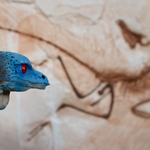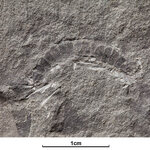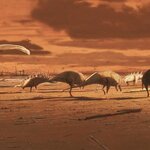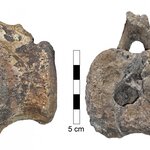Paleontology

The Fossil Birds of the Jehol Biota have caused an international stir amongst palaeontologists. The Jehol outcrops of northeastern China has unearthed some of the most important Mesozoic bird specimens worldwide over the past two decades.
This is a tale of how that all began. Back in November 1993, Chinese palaeontologists Hou Lianhai and Hu Yoaming, of the Institute of Vertebrate Paleontology and Paleoanthropology (IVPP) in Beijing received a call from an excited local fossil collector.
He claimed to have quite a remarkable specimen on his hands. The team visited Zhang He at his home in…

A new paper supports the traditional relationship of dromaeosaurid ('raptors') and troodontid theropods as the closest relatives of birds, but also supports the status of the controversial anchiornithine theropods as the earliest birds.
The authors say theirs is the most comprehensive study of feathered dinosaurs and early birds into the evolutionary relationships of dinosaurs at the origin of birds. They used an analytical pipeline to search for evolutionary trees, and estimated how each species may have crossed the stringent thresholds for powered flight.
Using their evolutionary tree, the…

Scientists have sequenced the genome of the tuatara, a single species reptile which originated in the Triassic period around 250 million years ago but is now only found in New Zealand, and it revealed an unusual architecture - it is mammal and reptile.
Its genome shares features with those of mammals such as the platypus and echidna.
Some sequences of DNA move or jump location, they are even referred to as 'jumping genes', and those found in the tuatara are most similar to those found in platypus while others are more similar to those in lizards.
The genome of the contentious tuatara…

Well-preserved footprints from the Lower Cretaceous Jinju Formation of South Korea, 110 million years ago, show that an ancestor of modern-day crocodiles, named Batrachopus grandis, walked on two feet.
Palaeontologists knew that some crocodiles from the "age of dinosaurs" were more adapted to life on land than their modern relatives but those were smaller creatures, about three feet long with footprints showing they walked on all fours. Batrachopus grandis was instead 12 feet in size and bipedal. It is more like a Gorn from the television show "Star Trek" than what we think of as a…

A 425-million-year-old Kampecaris obanensis millipede fossil is the world's oldest "bug." It is older than any known fossil of an insect, arachnid or other related creepy-crawly and it was found on the Scottish island of Kerrera.
It's about 75 million years younger than the age other scientists have estimated the oldest millipede to be using a technique known as molecular clock dating, which is based on DNA's mutation rate. Other research using fossil dating found that the oldest fossil of a land-dwelling, stemmed plant (also from Scotland) is 425 million years old and 75 million years…

The Hallstatt Limestone is the world's richest Triassic ammonite unit, yielding specimens of more than 500 ammonite species.
Along with diversified cephalopod fauna — orthoceratids, nautiloids, ammonoids — we also see gastropods, bivalves, especially the late Triassic pteriid bivalve Halobia (the halobiids), brachiopods, crinoids and a few corals. For microfauna, we see conodonts, foraminifera, sponge spicules, radiolaria, floating crinoids and holothurian sclerites — polyp-like, soft-bodied invertebrate echinozoans often referred to as sea cucumbers because of their similarities in size,…

The oldest fossil of a modern bird yet found dates from the age of dinosaurs and was found in a limestone quarry near the Belgian-Dutch border, making it the first modern bird from the age of dinosaurs found in the northern hemisphere.
It's officially termed Asteriornis maastrichtensis, in reference to Asteria, the Greek Titan goddess of falling stars, but the scholars who named it just call it "Wonderchicken." Though the fossil didn't look like much on first glance, a few small leg bone fragments poking out from a piece of rock the size of a deck of cards, even those small bones…

Stegosaurs are among the most recognizable dinosaurs because they left a lasting impression, including on a Scottish island.
Analysis of footprints show stegosaur roamed the Isle of Skye about 170 million years ago. it wasn't an isle then, it was a long-lost island in the Atlantic, and the site on the north-east coast was at the time a mudflat on the edge of a shallow lagoon. It contains a mixture of footprints, which means dinosaurs on Skye were more diverse than known.
Large stegosaurs could grow to almost 30 feet long and weigh more than six tons but the short sequence of…

A primitive bee from 100 million years ago has two things in common with bees of today; pollen and a parasite that caused its demise, much like varroa mites cause periodic colony collapse disorder today.
The mid-Cretaceous fossil from Myanmar provides the first record of a primitive bee with pollen and also the first record of the beetle parasites, which continue to show up on modern bees today. Beetle parasites may have caused the flight error that was deadly for the insect. The Discoscapa apicula specimen became stuck in tree resin and thus preserved in amber, and has now been…

Beliefs that tumors are caused by the modern world's food and chemicals have suffered a setback. A 60-million-year setback.
The fossilized tail of a young dinosaur from in southern Alberta, Canada had the benign tumor as part of the pathology of LCH (Langerhans cell histiocytosis), a rare and sometimes painful disease that still afflicts humans, particularly kids.
The first clue was the shape of cavities in the vertebrae of a tail of a young dinosaur of the grass-eating herbivore species. The large cavities in two of the vertebrae segments were extremely similar to the cavities produced by…